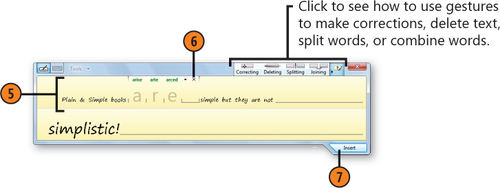The Tablet PC Input
Panel isn't just for Tablet PCs anymore! You can enter text in a
program by writing on the Input Panel using a pen-sensitive computer
(such as a Tablet PC) or a touch-sensitive computer, or you can use a
digitizing pad with a stylus or similar
interface tool, or even just your mouse. The Input Panel has two writing
modes—freehand style, in which you write as you would on paper, and
character by character, in which you write one character at a time.
However, these two modes are similar—you can even use the Character Pad to make corrections to your text when you use the Writing
Pad. Whichever method you use to write your text, the program
recognizes your writing and converts it into standard digital text. You
can then insert the text into a document.
1. Write Your Text
Make sure that the program into which you want to insert your text is running. Then click the Start button, and either type inp in the Search box of the Start menu and then click Input Panel, or choose Tablet
PC Input Panel from the Tablet PC submenu to start the program. If the
Input Panel is already running but is minimized, click or tap the Input
Panel tab.
Click the Writing Pad button if it isn't already selected.
If your text isn't recognized correctly, click the incorrect word.
Do either of the following:
Click Close or click outside the word.
Click Insert to insert the text into your program.


Tip:
With so many different input methods and types
of hardware, we can't describe in exact detail all the ways you can use
your equipment. For example, if you're using your mouse, hold down the
left mouse button to write. If you're using a stylus or a finger, just
write and tap to execute a mouse-click. You'll need to experiment to
find the best way to use your input system with these Tablet PC tools.
2. Add Other Elements
With no written text in the Input Panel, use the navigation buttons to move the insertion point to the location where you want it in the program.
Tap or click any of the following:
The typographic element you want
The editing keys to delete any content
The Num button to display the Number pad, the Sym button to display the Symbols pad, or the Web button to display the Web Quick Keys pad, and then the item you want to insert into your document
Tip:
If you click the Close button, the Input Panel
moves off the Desktop but doesn't close. To use it again, click the edge
of the Input Panel to restore it. To close the Input Panel, choose Exit
from the Options menu.




Tip:
To modify the Input Panel's location; to improve the handwriting recognition; or to change the way the Input Panel opens, edits existing text, and displays handwritten text, open the Tools menu before you write any text.